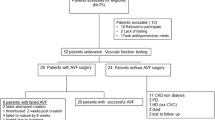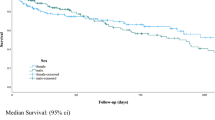Abstract
The aim of this study was to demonstrate that hyperemic response is a predictor of access failure. We conducted a review of a prospective database of dialysis access patients with preoperative hyperemia studies from June 1998 to August 2002. These consisted of bilateral brachial artery pressures followed by flow velocity measurements of the brachial artery and radial artery at rest and after 3 min of arm ischemia. Measurements were taken by using a cuff placed above the antecubital fossa and inflated to 20 mmHg above systolic pressure. There were no differences recorded in brachial artery pressures for the bilateral studies. Hyperemic response was entered into a stepwise Cox regression to determine its effect on access failure. Access failure was defined as failure to mature or thrombosis. Accesses were placed according to Dialysis Outcome Quality Intiatives (DOQI) guidelines. Kaplan-Meier survival analysis was performed. Log-rank testing was used to compare patency results. Censored end points were death, renal transplant, and access survival to the end of the study period. Fistulas that failed to mature were considered failures at 3 months. Arteries with a <5 cm/sec increase in peak systolic velocity were defined as nonresponders. The 59 arteries used for dialysis access were divided into two groups on the basis of their hyperemic response in cm/sec. The nonresponders were compared with the remainder of accesses performed. Accesses based on arteries with absent or minimal hyperemic response had significantly lower (p < 0.0005) secondary patencies by Kaplan-Meier analysis. Upon further stratification into radial and brachial arteries, the significant difference in secondary patency remained for radial artery–based accesses (p = 0.024) and approached statistical significance for brachial artery–based accesses (p = 0.057). A significant difference was not seen in primary patencies, indicating that accesses based on arteries with an acceptable hyperemic response are more likely to be salvaged by revisions. A nonresponsive radial artery was not a significant predictor of a nonresponsive brachial artery in the same extremity by binary logistic regression (p = 0.111), and a nonresponsive artery was not a significant predictor of nonresponsiveness in the corresponding artery in the contralateral extremity (p = 0.137). Cox regression analysis revealed that the hyperemic response is a significant predictor of failure to mature or thrombosis. Hyperemic testing is a useful means of evaluating adequate arterial inflow for dialysis access. Reduced or absent hyperemic response is an independent predictor of access failure.

Similar content being viewed by others
References
M Silva R Hobson P Pappas et al. (1998) ArticleTitleA strategy for increasing use of autogenous hemodialysis access procedures: impact of preoperative noninvasive evaluation J. Vasc. Surg. 27 302–308 Occurrence Handle9510284
R Mendes M Farber W Marston et al. (2002) ArticleTitlePrediction of wrist arteriovenous fistula maturation with preoperative vein mapping with ultrasonography J. Vasc. Surg. 36 460–463 Occurrence Handle10.1067/mva.2002.126544 Occurrence Handle12218967
R Joannides WE Haefli L Linder et al. (1995) ArticleTitleNitric oxide is responsible for flow-dependent dilatation of human peripheral conduit arteries in vivo Circulation 91 1314–1319 Occurrence Handle1:CAS:528:DyaK2MXkvF2ks74%3D Occurrence Handle7867167
R Joannides EH Bakkali LR Franck et al. (1997) ArticleTitleAltered flow-dependent vasodilatation of conduit arteries in maintenance haemodialysis Nephrol. Dial. Transplant. 12 2623–2628 Occurrence Handle10.1093/ndt/12.12.2623 Occurrence Handle1:STN:280:DyaK1c%2Fpt1OgsQ%3D%3D Occurrence Handle9430862
JR Bradley DB Evans AJ Cowley (1988) ArticleTitleAbnormalities of the peripheral circulation in patients with chronic renal failure Nephrol. Dial. Transplant. 3 412–416 Occurrence Handle1:STN:280:BiaD3MrivF0%3D
N Takeshi Y Ishigami Y Otaki et al. (2002) ArticleTitleImpairment of vascular response to reactive hyperemia and nitric oxide in chronic renal failure Nephron 92 529–535 Occurrence Handle10.1159/000064078 Occurrence Handle12372934
DS Celermajer KE Sorensen VM Googh et al. (1992) ArticleTitleNon-invasive detection of endothelial dysfunction in children and adults at risk of atherosclerosis Lancet 340 1111–1115 Occurrence Handle1:STN:280:ByyD287lt10%3D Occurrence Handle1359209
Author information
Authors and Affiliations
Corresponding author
About this article
Cite this article
Wall, L.P., Gasparis, A., Callahan, S. et al. Impaired Hyperemic Response Is Predictive of Early Access Failure. Ann Vasc Surg 18, 161–171 (2004). https://doi.org/10.1007/s10016-004-0006-9
Published:
Issue Date:
DOI: https://doi.org/10.1007/s10016-004-0006-9




